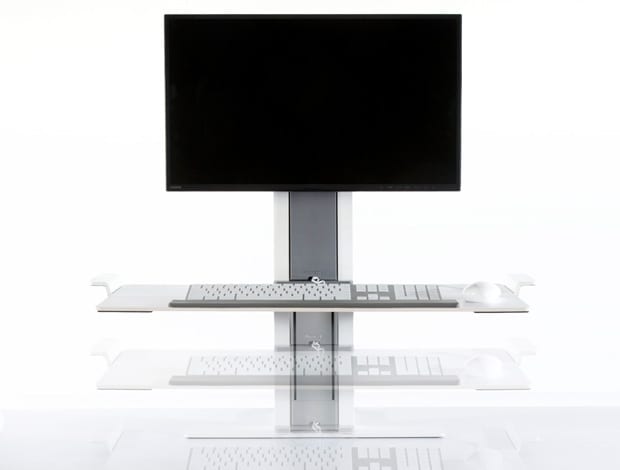 ||
||
Sit/stand desks have proved a fairly radical idea for companies to buy in to, at least in the UK: which is why humanscale’s add-on might offer a useful compromise
Back at the turn of the millennium, I remember going to the launch of a retrospective of the work of Peter Opsvik. As memory serves, the Norwegian industrial designer’s welcoming speech consisted of him exclaiming: “Less sitting, more moving!” before picking up a saxophone and squealing out some jazz. As the show was largely concerned with chairs it seemed a mildly eccentric thing to say. Spool forward 15 years and sitting down seems to have joined a long list of things of which we used to be quite fond but are now deeply ashamed – like smoking, New Labour and watching female dance troupes on Top of the Pops.
It’s telling, for instance, that when I go to Humanscale’s showroom to take a look at QuickStand, launched at last year’s Orgatec, the introduction to the product isn’t conducted by the designer or marketing team (although the latter are in attendance) but by the company’s associate ergonomist, Kirsty Angerer.
As the website for health campaign Get Britain Standing attests, too much sitting down is bad for us: stopping the flow of electricity to our legs, reducing the metabolic rate and shutting down enzymes responsible for burning off fat. It can lead to anything from cardiovascular disease to depression and dementia. In response, the office furniture industry has produced a slew of products that encourage office workers to stand up a little bit more.
I reviewed Humanscale’s Float desk on these pages a couple of years ago. And a very decent product it is too. However, purchasing it in bulk represents a profound cultural shift for a company: what if it had already noticed the workplace zeitgeist and invested in bench-style workstations, for instance?

A product like QuickStand is something of a compromise. Companies can keep their existing systems and fit the product on to the required desks using a C-clamp, which attaches to the back of the top. When you’re sitting on your backside, the platform, on which the keyboard rests, sits on the work surface; however, when you want to stand up you simply grab the handles on either side and gently pull upwards. The platform locks automatically into position, using a counterbalance tension-control mechanism. Meanwhile the monitor position can be adjusted independently – up, down and tilted – and cabling is integrated, meaning users can simply plug in and start working. Humanscale reckons it takes 15 to 20 minutes to install.
While sit/stand products have proven popular in Scandinavia, they haven’t been wholly embraced by the UK market. It maybe that QuickStand will allow cautious facilities managers to experiment with the notion without breaking the corporate budget – Float, it’s worth pointing out, costs around twice as much as its new product for the contract market (and will set you back a cool £1399 if you decide to buy one for yourself at John Lewis) – or replacing all the existing furniture.
Any issues? Well, it’s a bit like getting the hang of the clutch on a new car: you’ve initially got to be careful with the tension adjustment. When I first applied some weight to the platform it shot down a little alarmingly – however, this can be easily tailored using an Allen key (which would most likely reside with your company’s facilities manager).
Arguably, though, the biggest concern is the way that the 710mm-high product cuts down the user’s vision across the office when seated, immediately stymieing the raison d’être of an open-plan workplace and those aforementioned benching systems, which are surely concerned with improving communication and collaboration (as well as saving space and money). There is a danger, too, that they will add to the visual clutter of the typical office. QuickStand could force facilities managers to question their priorities: the aesthetics of the office or the health of their workforce.




















